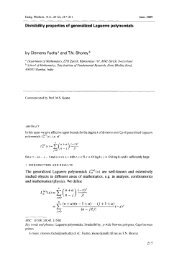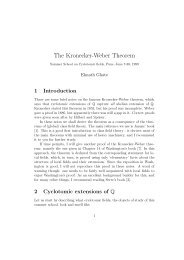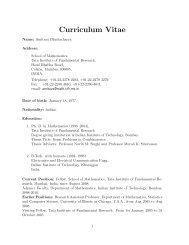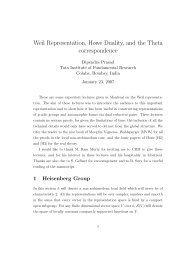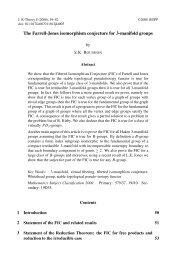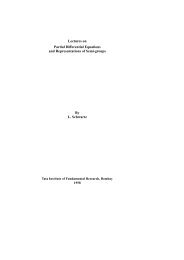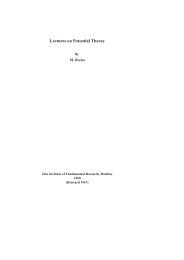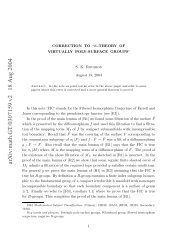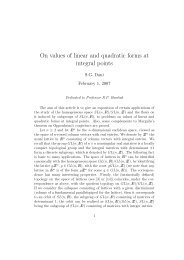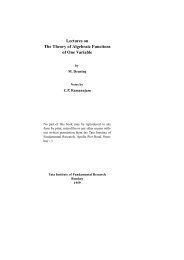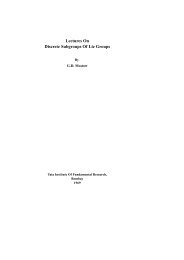Extensions of Schur's irreducibility results - Tata Institute of ...
Extensions of Schur's irreducibility results - Tata Institute of ...
Extensions of Schur's irreducibility results - Tata Institute of ...
You also want an ePaper? Increase the reach of your titles
YUMPU automatically turns print PDFs into web optimized ePapers that Google loves.
Shanta Laishram and T. N. ShoreyBy using estimates <strong>of</strong> π(ν) from Lemma 4.1, we obtainTherefore we have(π(4k) − π(k)) log kk 4 log k 1.2762(1 +log 4k log 4k ) − log klog k − 1( 4 1 − log 4 ) (1 + 1.2762log 4k log 4k() 4 1 − − 1 3.log 4 − 1.2762log 4k)− 10 > log(0.4) − 18k− .5 log k+ log( 335.7k2.83 ) − k −14 log(2.83) − 4.5.The right hand side <strong>of</strong> the above inequality is an increasing function <strong>of</strong> k and the inequality is notvalid at k = 10 6 . This is a contradiction.8. Pro<strong>of</strong> <strong>of</strong> Theorems 5By Theorem 4, we restrict to those triplets (n, a, k) given in the statement <strong>of</strong> Theorem 4 witha 12. We now factorize f a (x) with a 0 a n = ±1, a 1 = a 2 = . . . = a n−1 = 1 to find that these f a (x)are irreducible. Hence the assertion follows.9. Pro<strong>of</strong> <strong>of</strong> Theorem 1For the pro<strong>of</strong> <strong>of</strong> Theorem 1, we put α = a through out this section. As remarked in Section1 after the statement <strong>of</strong> Theorem 1, we may assume that 10 < a 40. For n 18 and n ∈{24, 25, 27, 30, 32, 36, 45, 48, 54, 60, 64, 72, 75, 80, 90, 112, 120}, we find that L (a)n (x) is irreducible exceptfor (n, a) listed in Theorem 1. Thus we assume n > 18, n /∈ {24, 25, 27, 30, 32, 36, 45, 48, 54, 60,64, 72, 75, 80, 90, 112, 120}. Assume that L (α)n (x) is reducible. Then L (α)n (x) has a factor <strong>of</strong> degree kwith 1 k n 2. First we prove the following lemma.Lemma 9.1. Let k 2. Then L (a)n (x) has no factor <strong>of</strong> degree k.Pro<strong>of</strong>. Let k 2 and a 40 if k = 2. We may restrict to those (n, k, a) given in the exception <strong>of</strong>Theorem 4. For each <strong>of</strong> these triplets (n, k, a), we first check if there is a prime p k + 2 with (10)such that either (8) or (9) is satisfied and they are excluded by Lemma 1. We are now left withtriples (n, k, a) given by k = 2, (n, a) ∈ {(100, 21), (40, 24), (256, 33), (42, 40)}. For these (n, a), wecheck that L (a)n (x) are irreducible.Let k = 2 and 40 < a 50. Suppose n /∈ N 1 (23) and n+a /∈ N 1 (23). Then P 1 = P (n(n−1)) > 23and P 2 = P ((n + a)(n + a − 1)) > 23. Further either P 1 ∤ (a + 1)(a + 2) or P 2 ∤ (a + 1)(a + 2))and the assertion follows by Lemma 1. Therefore we may assume that either n = N ∈ N 1 (23)or n + a = N ∈ N 1 (23). Further we may also suppose that P (n(n − 1)(n + a)(n + a − 1)) P ((a + 1)(a + 2)) otherwise assertion follows by Lemma 1. For N ∈ N 1 (23) and N > 10000, wecheck that P ((N −a)(N −a−1)) > P ((a+1)(a+2)) and P ((N +a)(N +a−1)) > P ((a+1)(a+2))except when (a, N) = (45, 10648), (46, 12168) where P (N(N − 1)) = 13, 23, respectively. Observethat N(N − 1)|n(n − 1)(n + a)(n + a − 1). By taking p = P (N(N − 1)), the assertion follows fromLemma 1. We now consider n 10000. Let a be given. By Lemma 1, we first restrict to those n forwhich P (n(n − 1)(n + a)(n + a − 1)) P ((a + 1)(a + 2)). Further we check that there is a primep|n(n − 1)(n + a)(n + a − 1), p > 7 and p ∤ (a + 1)(a + 2). Lemma 1 implies the assertion now.By Lemma 9.1, we need to consider k = 1. If there is a prime p|n(n + a), p ∤ (a + 1) with either14



